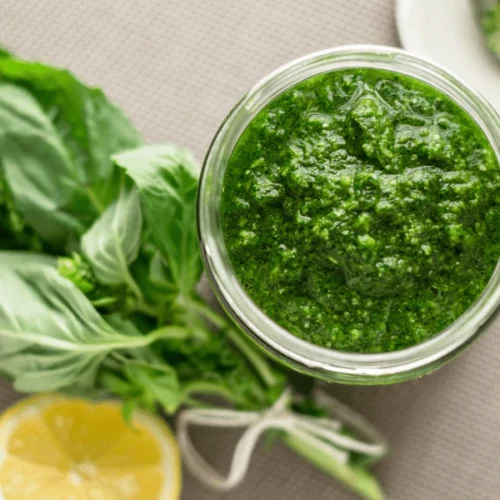Classic Pesto Recipe
This Classic Pesto Recipe showcases a traditional Italian sauce known for its vibrant green color and rich, aromatic flavor. Made from fresh basil, garlic, pine nuts, Parmesan cheese, and olive oil, this versatile pesto adds a delicious touch to pasta, sandwiches, and various dishes. Originating from Genoa, Italy, it has become a global kitchen staple, celebrated for its simplicity and bold taste.
Equipment
- Food Processor or Mortar and Pestle: For blending or grinding the pesto ingredients.
- Measuring Cups and Spoons: For accurately measuring ingredients
- Spatula: For scraping down the sides of the food processor or mixing bowl.
- Knife: For chopping garlic and basil (if not using a food processor).
- Cutting Board: For preparing and chopping ingredients.
- Storage Container: For storing the pesto, preferably an airtight container.
Ingredients
- Fresh Basil Leaves: The star ingredient, providing the vibrant green color and aromatic flavor.
- Garlic Cloves: Adds a pungent, aromatic kick to the sauce.
- Pine Nuts: Contributes a subtle, creamy nuttiness.
- Parmesan Cheese (grated): Gives the pesto its rich, savory flavor.
- Extra Virgin Olive Oil: The base that binds the ingredients and adds a smooth, fruity richness.
- Salt and Pepper: For seasoning to taste.
- Lemon Juice (optional): Adds a touch of acidity to balance the flavors.
Notes
- Choosing Basil: For the best flavor, use fresh, young basil leaves. Older leaves can have a slightly bitter taste. If your basil has thick stems, remove them to avoid a fibrous texture in your pesto.
- Nuts Substitutes: While pine nuts are traditional, you can substitute with walnuts, almonds, or even cashews for a different flavor profile. Lightly toasting the nuts before adding them to the pesto can enhance their flavor.
- Cheese Variations: Parmesan is classic, but you can also try Pecorino Romano for a sharper taste. For a dairy-free version, nutritional yeast can be used as a cheese substitute.
- Consistency: If your pesto is too thick, you can thin it out with a little more olive oil or a splash of pasta cooking water. If it’s too thin, add more basil, nuts, or cheese to thicken.
- Storing Pesto: Pesto can darken when exposed to air. To keep it bright green, store it in an airtight container with a thin layer of olive oil on top. It will keep in the refrigerator for up to a week or in the freezer for up to 3 months.
- Using Pesto: Pesto is incredibly versatile. Toss it with pasta, spread it on sandwiches, use it as a pizza base, or drizzle it over grilled vegetables or meats.
- Mortar and Pestle vs. Food Processor: Traditional pesto is made using a mortar and pestle, which gives the sauce a rustic texture and deeper flavor. A food processor is quicker and more convenient but can create a smoother pesto. Choose the method based on your preference.
- Allergen Alert: Pesto typically contains nuts and dairy. Be sure to inform guests of these ingredients, especially if you’re serving a crowd with potential allergies. You can make nut-free and dairy-free versions if needed.
